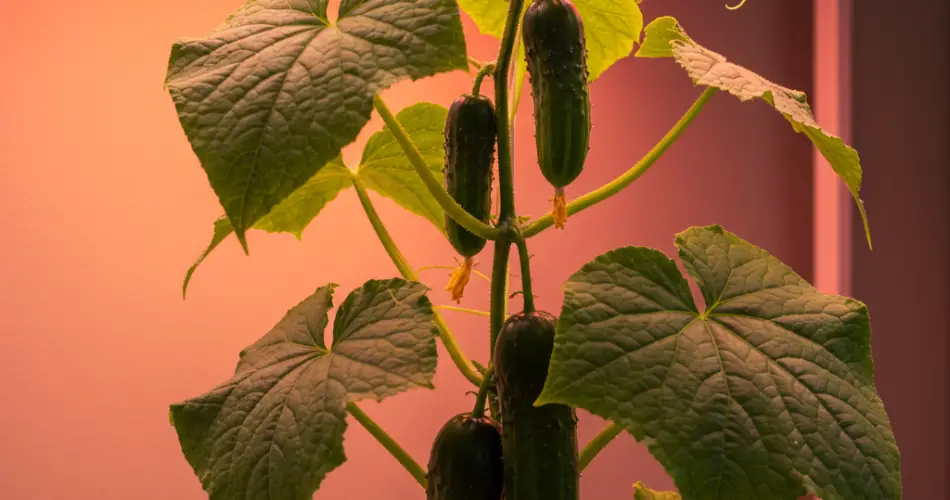Growing cucumbers indoors might seem intimidating, especially if you’re new to gardening, but with the right approach, it’s entirely achievable. Cucumbers are fast-growing, productive plants that thrive with proper care — and you don’t need a garden to enjoy a fresh harvest. All you need is a bright window, a little patience, and a few simple tips to help your indoor cucumber plants flourish.
Whether you’re short on outdoor space or want to extend the growing season year-round, this guide will walk you through how to grow cucumbers indoors, even if you’ve never grown a plant before.
Why Grow Cucumbers Indoors?
Indoor gardening offers several benefits. First, it allows you to grow food in any season, regardless of outdoor weather. Second, growing cucumbers indoors reduces the risk of pests and diseases. And finally, it’s convenient — you can pick fresh cucumbers straight from your windowsill or kitchen.
Indoor cucumber plants can also serve as decorative greenery, climbing on supports and adding a lush, natural touch to your home.
Choosing the Right Cucumber Variety
Not all cucumber types are suitable for indoor growing. When gardening in small spaces, look for compact or bush varieties that don’t require as much room to spread. Some of the best cucumber varieties for indoor growing include:
-
Bush Champion
-
Spacemaster
-
Patio Snacker
-
Bush Pickle
These are bred for container gardening and tend to be shorter, more manageable plants. Many are also self-pollinating, making them ideal for indoor environments where insects are absent.
What You’ll Need
To grow cucumbers indoors successfully, gather the following materials:
-
A 3-5 gallon container or pot with drainage holes
-
High-quality potting mix, preferably organic and designed for vegetables
-
A trellis or support (bamboo stakes or a small indoor trellis)
-
Cucumber seeds or seedlings
-
A sunny window or grow light
Cucumbers love warmth and light, so providing at least 6–8 hours of direct sunlight daily is essential. If natural light is limited, consider investing in a full-spectrum LED grow light.
Planting Cucumbers Indoors
Start by filling your container with potting mix, leaving about an inch of space at the top. Sow cucumber seeds ½ inch deep in moist soil. Plant 2–3 seeds per pot, then thin out the weaker seedlings once they’re a few inches tall, leaving the strongest one to grow.
If using seedlings from a nursery, transplant them carefully into the pot without disturbing the root ball too much.
Position the container in a warm, sunny location. Cucumbers grow best at temperatures between 70–85°F (21–29°C). If your space is cooler, a heating mat can help maintain warmth at the root zone.
Supporting Your Cucumber Plants
As cucumbers grow, they’ll need support to keep their vines off the ground. Indoors, a small trellis or vertical support system works best. Tie the vines loosely using soft string or plant clips as they grow. Vertical growth not only saves space but also improves air circulation and reduces the chance of mold or mildew.
Watering and Feeding
Cucumbers are thirsty plants, especially when grown in containers. Keep the soil consistently moist but not soggy. Water when the top inch of soil feels dry. Be careful not to let the roots sit in water — always empty any excess water from saucers beneath your pots.
Feed your indoor cucumbers with a balanced, water-soluble fertilizer every 2–3 weeks. You can also use organic options like compost tea or fish emulsion for more natural nutrition.
Pollination Indoors
Many indoor-friendly cucumber varieties are parthenocarpic, meaning they don’t need pollination to produce fruit. However, if you’re growing a type that has both male and female flowers, you may need to hand-pollinate.
Use a small paintbrush or cotton swab to transfer pollen from the male flower (which lacks a small fruit at its base) to the female flower (which has a tiny cucumber-shaped bulge). This simple step can significantly increase your harvest.
Common Challenges and Solutions
Yellowing Leaves
This may indicate overwatering, nutrient deficiency, or lack of light. Adjust your care routine accordingly.
Powdery Mildew or Mold
Ensure proper airflow by avoiding overcrowding and watering early in the day so the leaves dry out quickly.
No Fruit Development
This is often due to poor pollination or inadequate light. Hand-pollinate if necessary and consider adding a grow light if sunlight is insufficient.
Harvesting Cucumbers
Depending on the variety, cucumbers are typically ready to harvest 50–70 days after planting. Harvest when they are firm, green, and about 6–8 inches long. Don’t let them over-ripen on the vine, as this can reduce future fruit production.
Use scissors or pruning shears to cut cucumbers from the vine rather than pulling, which can damage the plant.
Final Tips for Indoor Cucumber Success
-
Rotate the pot occasionally for even light exposure.
-
Wipe down leaves with a damp cloth if dust accumulates.
-
Reuse or compost spent soil, but rotate crops to reduce disease risk.
-
Start new seeds every few months for a continuous supply of fresh cucumbers.
Conclusion
You don’t need a green thumb to grow cucumbers indoors. With the right variety, a sunny spot, and a little care, even first-time gardeners can enjoy fresh, homegrown cucumbers right from their kitchen. It’s a satisfying way to bring greenery into your home and enjoy the taste of summer all year long.



